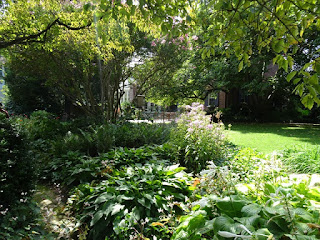Moving on to the next old English named town we sailed up the Choptank River. Michner based most of his novel,
Chesapeake, around this river so it was a must stop for us. This was the center of quite a few innovative boat designs, the Underground Railroad thanks to native Harriet Tubman, and shipping. It is also home to the annual Chesapeake Skipjack Races which we managed to miss by a day, Rats! We walked quite a bit and met several really friendly people, especially Fred who say us walking with all our bags to the grocery store and gave us a ride. He turned out to be a local sailor who cruises in the winter so he recognized fellow sailors on a reprovisioning trudge. People waved from their front porches and we happy to share their stories along the river, overall, a nice stop. Next we head farther south in the bay to the disappearing island of Tangiers. I'll update again when I next have a good wifi connection.
 |
This was such a unique porch rail design. I can only think the original
owner was a paddlewheel captain. |
 |
| The fountain at the courthouse. |
 |
This boat was at a restoration yard. No story on it, just looked like
it probably had an interesting tale. |
 |
We saw this striking piece as we entered the town. It is called Sailwatch and
the building in the background is the county visitor's center. |
 |
The sign says historic drawbridge but doesn't say why it's historic.
We found a lot of only half-information in Cambridge. |
 |
| A row of skipjacks on the town's seawall. |
 |
| A beautiful example of a trailboard and carved sprit head. |
 |
Another colorful trailboard and this one comes with a story. As we
were standing on the side admiring the boats, a very excited guy rushed up from the
nearby restaurant. It turns out his great-grandfather had built this boat
and named it for his grandmother. It had changed hands since he last saw it
and managed a ride for his grandmother aboard back in the 1980s. He had lost
track of the boat and happened to be eating lunch and saw her name. |
 |
| All working skipjacks must display their license on the rigging. |














































































